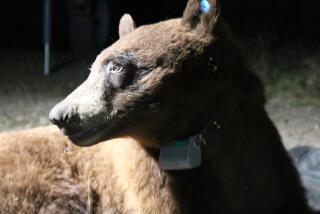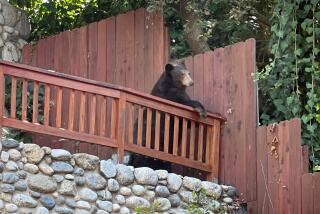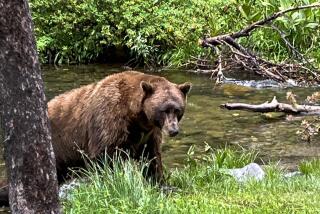Close encounters of the bruin kind on the increase
- Share via
HARLAN, KY. — Bobby Koger was deer hunting on a Kentucky hillside when a black bear gave him the fright of his life.
The 300-pound animal, apparently unhappy that an intruder was on his turf, came charging and didn’t stop until Koger raised his .50-caliber muzzleloading rifle and fired from point-blank range. A hunting companion who witnessed the attack from a distance also shot the bruin, which wheeled, ran a short distance and collapsed.
Conservation officers concluded that the hunters had fired in self-defense at a bear that had lost its natural fear of humans.
With black bear populations rising, run-ins have become almost common -- more than 15,000 in the last year in states east of the Mississippi River, according to a survey of state wildlife agencies.
Canadian bear researcher Hank Hristienko, who conducted the survey in January, found that 18 Eastern states were seeing more encounters with bears.
Most encounters involve hungry bears raiding backyard bird feeders or toppling garbage bins, but sometimes they’re harrowing. In a 2006 attack, a 210-pound male bear killed a 6-year-old girl and mauled her 2-year-old brother as well as her mother, who had tried to fend off the animal. The attack occurred during a family outing in Tennessee’s Cherokee National Forest.
Some bears have become brazen, dining beneath backyard fruit trees, raiding pet food bowls, even chasing campers.
At a park near Prestonsburg, Ky., last year, tourists hid inside a cabin until rangers arrived to chase a bear away.
Bears have also become road hazards. Wildlife agencies reported more than 1,300 struck by automobiles in 2008.
The U.S. bear population more than doubled between 1989 and 2006, rising from 165,000 to more than 350,000, according to the International Assn. for Bear Research and Management, a conservation nonprofit that takes a periodic census of the animals. The Eastern states alone now have about 163,000 bears, according to findings Hristienko released in May.
Biologists with the same group found nearly 20,000 reported conflicts between bears and humans in 37 states in a 2006 survey of state wildlife agencies.
More recently, 18 states in the Eastern region reported an increase in bear-human conflicts over the last year, Hristienko found.
Tennessee reported the largest increase: 1,000, compared with 300 a decade ago. That was followed by New York at 1,127 (up from 587) and New Jersey at 1,117 (up from 691).
Frank van Manen, a U.S. Geological Survey research ecologist and president of the bear association, said it wasn’t that the bears were becoming more aggressive but that bear populations were skyrocketing under state bans or limits on bear hunting.
“What we have seen throughout the eastern United States is quite a phenomenal range expansion of the black bear,” Van Manen said. “With the range expansion, the likelihood of the encounters is increasing.”
Black bears are the most common bear species in the U.S., with measurable populations in most states. Their larger cousin, the grizzly, is limited to the Northwestern states and Alaska. Bears eat just about anything, including meat, but tend to subsist mostly on insects, nuts, berries, acorns and other vegetation.
Stephanie Boyles, a wildlife scientist for the Humane Society of the United States, said that 14 people had been killed in attacks by black bears in North America since 2000. Boyles said an additional 10 people were killed by grizzlies during that period, mostly in Alaska and Canada.
In Kentucky, officials opened a hunting season for bears, a move pushed by the League of Kentucky Sportsmen to reinforce the animals’ fear of humans.
More than a century ago, bears thrived in Kentucky, but hunting and habitat loss led to their disappearance. Now the large animals have ventured back from neighboring states, and Kentucky residents are unaccustomed to living among them.
“You’ve got bears moving into areas where people live and you’ve got people moving into areas where bears live,” said Mark Ternent, a state bear biologist in Pennsylvania. “Both of those scenarios frequently involve people with little experience living around bears.”
Ternent said most of the encounters were harmless, ending with the bears running away.
“The average bear is afraid of people,” he said. “If it encounters a person, it would rather flee than fight.”
Boyles said people could prevent unwanted bear encounters by doing simple things like putting bird feeders out of reach of the animals, putting trash out only on the day it is to be picked up, and keeping pet food indoors.
Koger, a construction worker, said he had run across lots of bears over the years in the mountains of eastern Kentucky. Most of the time, he said, the bears don’t relish the encounters either.
“Usually they want to get away from you as much you want to get away from them,” he said.
--
Alford writes for the Associated Press.
More to Read
Sign up for Essential California
The most important California stories and recommendations in your inbox every morning.
You may occasionally receive promotional content from the Los Angeles Times.










